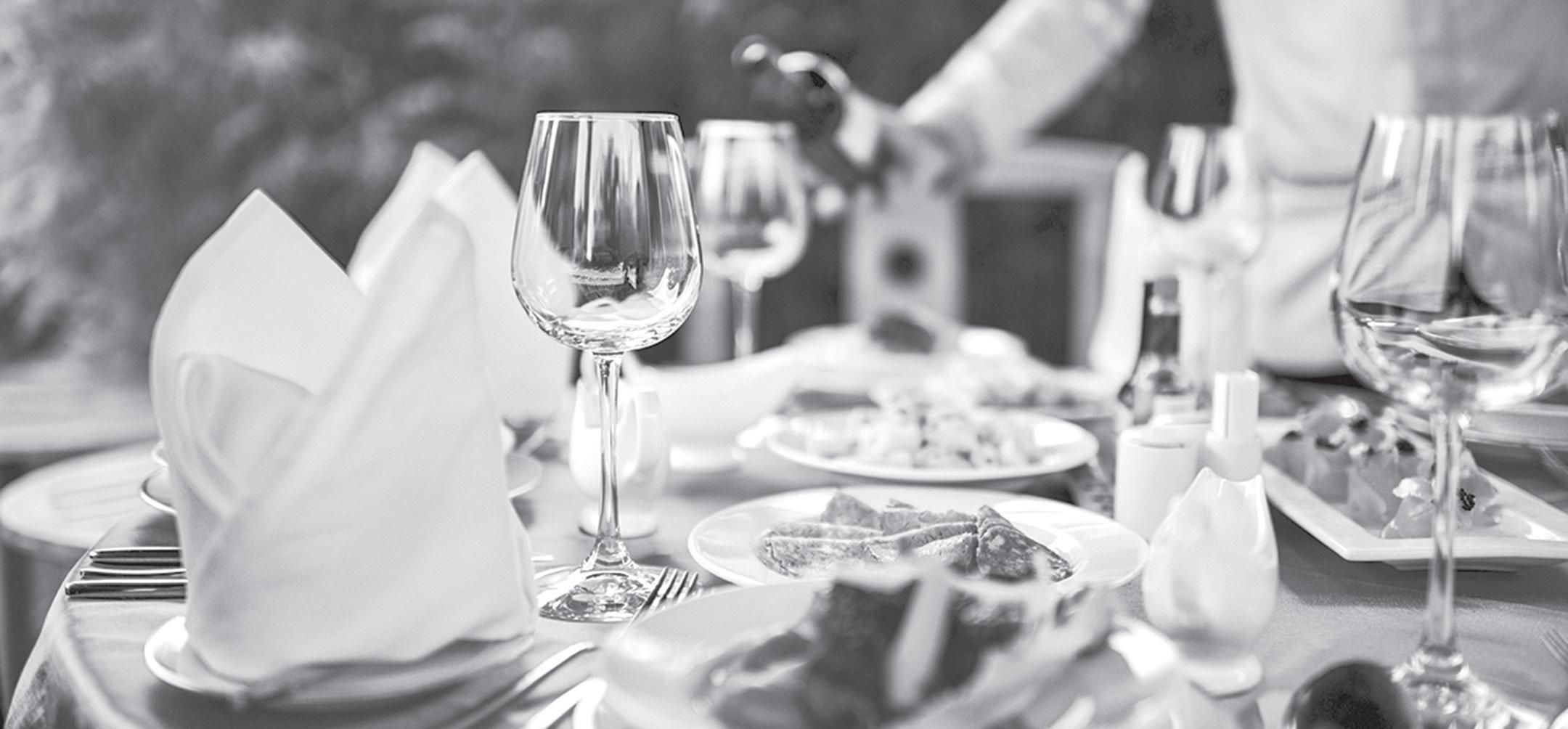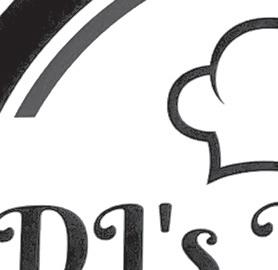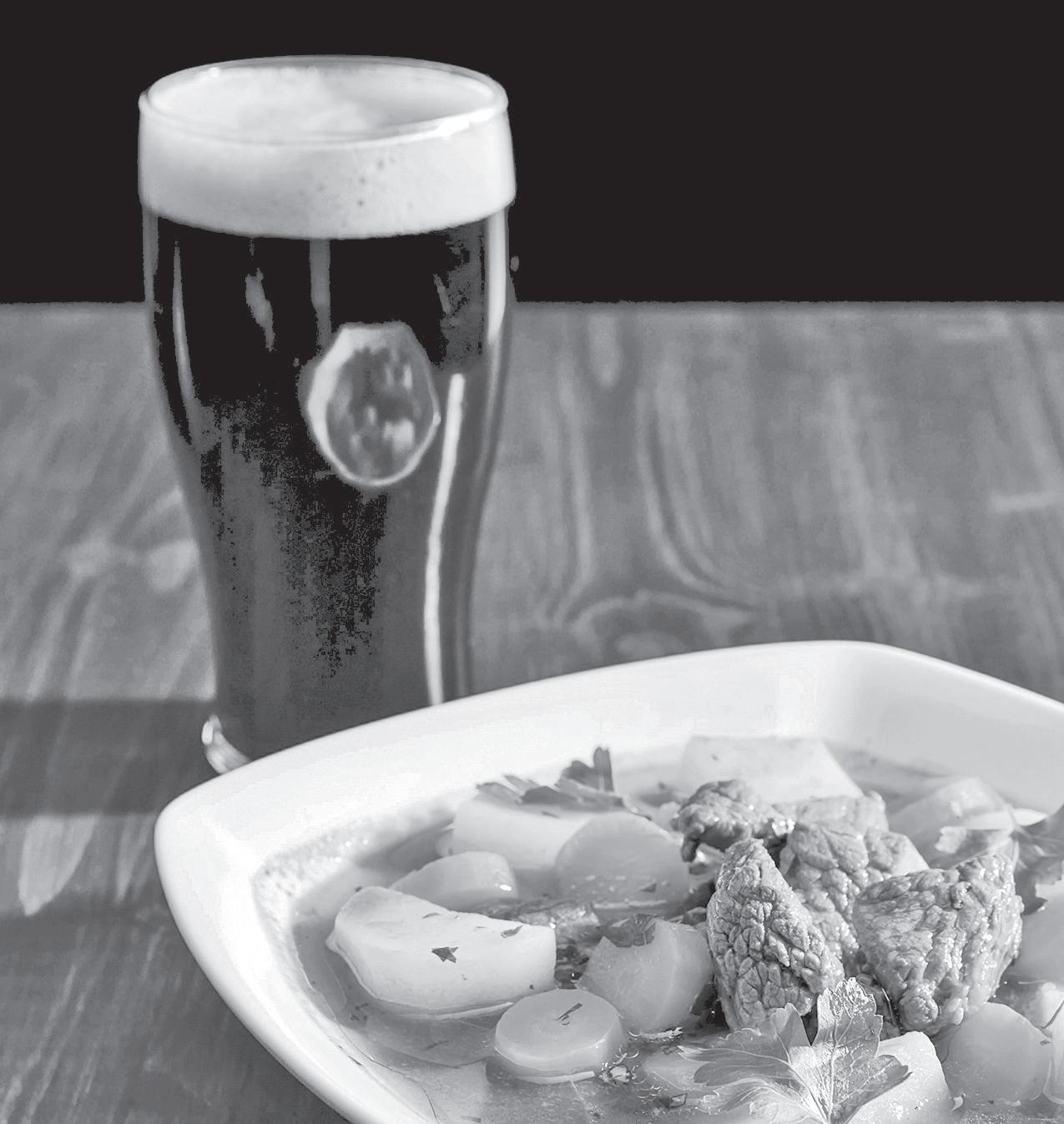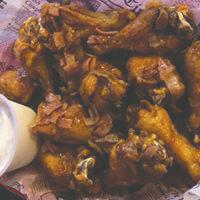






OLEAN — Whether it’s a resident looking for a Friday night fish fry, a former resident looking for a taste of home, or the experienced foodie making the trek, the area’s restaurants even prove themselves as attractions on their own.
“I think it’s very telling that when Greater Olean Area expats return for events, holidays, or other occasions, more often than not, their ‘mustdo’ list heavily features visits to the restaurants they grew up with,” said Adam Jester, interim CEO of the Greater Olean Area Chamber of Commerce. The Chamber
proudly counts dozens of area restaurants, food trucks and other operations among its members.
“Our area has for decades been blessed with an incredibly talented and robust hospitality and dining industry,” Jester said. “I think in many cases, we’ve been the beneficiary of
multiple generations passing down recipes and businesses over the years, and now that great history is complemented by comparative newcomers who bring an entirely new perspective. The sum of the parts is something we’re very fortunate to have here, as it contributes heavily to
Area ‘blessed’ by variety, quality in dining continued from page 2
the success of event and tourism efforts.”
A wide variety of options meets diners, Jester said.
“I think the range of culinary options has vastly improved over the last several decades,” he said. “Whether it’s independent restaurants, or locally franchised chains, residents have quite a number of style options to choose from. It’s amazing the versatility we see even within the specials from day to day of a given restaurant. In addition, as the way folks choose to eat, buy, and play has evolved in the last few years, it’s great to see our members evolve to meet consumers where they are, whether it’s well established locations adding outdoor patios, or participating in online delivery platforms, or the recent gains in popularity of food trucks and pop-ups.
Chamber member food vendors include:
3 C’s Catering, 3rd Base Bar & Grill, A&J’s Subs Pizza & Grill, Allegany American Legion
Charles Harbel Post 892, Angee’s Restaurant, AnnMarie’s Baklava, Applebee’s, Aramark @ OGH, Aramark @ St. Bonaventure, Beef
‘n Barrel Restaurant, Brothers Bistro, Burger

King (2 locations), Century Manor, Clark’s Subs, Domino’s Pizza, Dunkin’ Donuts, Four Mile Brewing, Friendly’s Restaurant;
GoTo Meals, Grand Slam, Granny’s Verona, Green Acres Cafe, The Hall, Homeplate News Inc., Hometown Bar and Grill, House’s Parkwood Tavern, Hungry Burro,
The Kopper Keg Restaurant, La Dolce
Vita, Luigi’s Pane and Pasta, Mangia 2.0 Pizza, Mickey’s, Mio Gelato/ Renna’s West, Mirchi
Bar-N-Grill, Myrge Cafe & Coffee House, Napoli
Pizza, The Old Library Restaurant, On the Side Sub Shop, Palmer Opera House, Perkins Restaurant & Bakery, Pizza Napoli Bradford Restaurant & Brick Oven Trailer, PizzaLand, Rafi’s Food Hub;
Randy’s “Up the River”, Randy’s Fireside, Red’s & Trudy’s Restaurant, Renna’s Pizza, Rusty Rooster Farm & Vintage LLC, Seneca Wolf Tracks, Sprague’s Maple Farms, State King, Subway, Sweet Ride Donut Truck, Talty’s Irish Pub, Tasta Pizza, The Pig Out Place, The Scoop, The Spot 2 Be, Tim Hortons (3 locations), Twist & Shake, Union Whiskey, Whispering Mountain

There are many choices for grabbing a great meal in the Bradford area, whether it’s a quick, to-go lunch from a food truck or deli, an outdoor dining experience, a sit-down meal or a tasty dessert.
Rustin Lippincott, new executive director of the Allegheny National Forest Visitors Bureau, relocated to the region recently. He shared his favorites: The Grocery Stretcher deli, Tack’s Inn, Model T, Taco Inc., Rookies, Kabobs at The Option House and The Westline Inn.
Members of the Visitors Bureau are as follows:
The Westline Inn, Taco Inc., Kabobs at The Option House, Rookies,
Willows Restaurant, Barrel House Restaurant, Runway Bar and Grill, Mama Jane’s, Pine Acres Country Club, CJ Spirits, Texas Hot Lunch & 4 Sons, West Side Grill, Mama Sue’s Cookie Jar, Docksider’s Cafe, Cottage House Restaurant, A Slice of the 80s
Outside dining: Tack’s Inn, Mount Jewett’s Kaffe Sol, Eddie’s on Main, Model T, Pizza Napoli, Bradford Brew Station and Table 105, John Williams European Pas-
try Shop, Foster Brook Creamery, Pizza Napoli, The Willows, Togi’s and Mad Dog 159.
The Bradford Area Chamber of Commerce has many restaurants on its membership roster. Members include Liberty Tavern, Waffled Up, Model T, Derrick City Diner, Foster Brook Creamery, CJ Bbq, Mama Janes, Tasta Pizza and Taproom, Togi’s Fam-
ily Restaurant, Togi’s Sub Shop, Great Wall, Rookies, Kabobs, Leo’s Sub Shop, Magic Bean, Runway Bar and Grill, Taco Inc., Papa Scoops, Pizza Napoli, Beefeater’s, Kennedy Street Diner, John Williams European Pastry Shop, Fox’s Pizza and Good Place Food Truck, The Lunch Bus food truck, Slice of the 80s and The Barn.

Just for fun!
from back in the day!
Two poached eggs on toast
- Water
- Butter
- Garlic
- Baked beans
- Put a hamburger on the grill
- Milk
- Seltzer or soda water
- Coffee with cream and sugar.
- A hot dog with sauerkraut
- Beef stew
- A hamburger with lettuce, tomato and onion
t - Eggs
Eggs on toast
- Buttered toast
- A cup of coffee
- A hot dog
- Onion
- A cup of black coffee
Spareribs (probably a pun on Eve being made from Adam’s rib)
- Tapioca pudding

CARD ENTITLES HOLDER TO ONE FREE 9-HOLE ROUND OF GOLF AT EACH OF THE PARTICIPATING GOLF COURSES. CHECK WITH COURSES FOR INDIVIDUAL RULES AND REGULATIONS. CARTS NOT INCLUDED WITH CARD.
•ALLEGANY GARAGE GOLF*
•ALLEGHENY HILLS GOLF COURSE & RESTAURANT
•BAVARIAN HILLS GOLF COURSE
•BIRCH RUN GOLF CLUB
•BLUEBERRY HILL GOLF CLUB
•BOLIVAR GOLF CLUB
•CARDINAL HILLS GOLF COURSE
•ELKDALE COUNTRY CLUB
•EMPORIUM COUNTRY CLUB
•ISCHUA VALLEY COUNTRY CLUB
•JACKSON VALLEY GOLF CLUB
•PINE ACRES GOLF & RV RESORT
•SMETHPORT COUNTRY CLUB
•WELLSVILLE COUNTRY CLUB
10-31-24.



You crack open the menu at the new local hot spot and immediately set your eyes on the perfect main course — say, salmon with curried spinach.
You’re ready to order until you spy yet another enticing option — a three-cheese baked pasta with porcini and radicchio. And there are a lot of dessert options. You can’t possibly eat it all, but choosing between them is giving you a serious stomachache.
Don’t shut your menu in frustration. Instead, foodandwine.com
advises, check out these seven expert tips for how to choose the right meal from an overwhelming number of delicious options.
1. Go with your gut
Like, literally. “Let yourself naturally gravitate to the dishes that grab your eye instantly— and if you need additional help, start searching for ingredients you love,” says chef and food consultant Chris Santos. For Santos, never passing up a menu item with mustard, and saying no to those that don’t. “I order anything that has mustard in its description,” he says.

2. Look for seasonal items.
Say you’re conflicted over a summer dessert selection: Let a fruit pie take precedent over placing an order for a cheesecake. Here’s why, according to mixologist Adam Seger: “Menu listings highlighting ingredients that are at their peak and may not be offered next time you return to this establishment,” he points out. “A seasonal dish will edge out a core dish that sounds just as good.”
3. Stick to the theme.
Most restaurants have a specialty, and sticking
to ordering those items can help remove so-so snacks from your musteat list. For example, “do not order fish at a steakhouse or steak at a seafood restaurant,” says Ben Lefenfeld, chef of La Cuchara in Baltimore. “There is a reason they focus on a type of cuisine.”
4. Foster relationships.
We’re not talking about with the person across the table. Rather, “keep you eye out for items that have a farm or place of origin description,” instructs Seger, and order those first.
“These represent special
vendor relationships to the restaurant and ... [an] ingredient that they are proud to highlight,” he says.
5. Pace yourself.
If you can’t choose a single dish, choose many and progress down the menu naturally, advises David Bazirgan, Bambara’s executive chef. That means starting with an appetizer or a small plate, then ordering a vegetable or fresh salad, and finishing the meal, if you still have room, with pasta, fish, or meat. “If you order a small amount at a time and create your own tasting
menu, it’s easier to stop when you feel full,” he says, “and to get a sense for every part of a menu.”
6. Get the server’s recommendation.
In other words, let the guy or gal who’s in-the-
know choose for you. “An experienced server is your closest ally in navigating a foreign or overwhelming menu,” says Lefenfeld. Plus, he points out, “there may be opportunities to order a half portion of several dishes to try multiple
continued from page 8
offerings, or there may be a dish that is an absolute must that they can recommend.”
7. Be adventurous.
As a last resort, if you still can’t choose, select the menu item that seems the most adven-
turous. “Start off with a couple of challenging dishes to share at the beginning, items that both sound challenging to be prepared perfectly and that may stretch what you normally would try,” advises Seger.
Proper dining etiquette has a place whether you’re enjoying a meal at a five-star restaurant, a fast-food joint or at home.
While there are some written rules about social etiquette, there also are unwritten rules rooted in courtesy. By following these guidelines, any dining experience can go smoothly.
When dining out or attending a party, direct your attention to fellow guests or dining partners and not your devices. Turn off the ringer, resist the urge to check the sports score, wait to text a friend until you’re done, and devote your attention to the meal.
The host or hostess is responsible for setting the tone of the meal and ensuring everyone is comfortable. Take a backseat to your host and let him or her guide the meal.
Restaurant wait times are not an exact science. Restaurant hostesses can offer an estimate, but it’s impossible to say exactly when you’ll be seated. Do not take

frustrations out on the staff. If time is of the essence, dine during off-peak hours or visit a less busy establishment.
Restaurants should be willing to cater to certain requests, especially if food allergies are a concern. However, do not act like the establishment is your personal kitchen. Make reasonable requests.
Make and keep reservations, which help keep the flow of the dinner party going smoothly. Arrive at a home on time, as party hosts likely have timed their foods accordingly and you don’t want to
delay or spoil the taste and presentation of the food.
Dining out with children presents an opportunity to teach them manners. To avoid meltdowns, be sure children are well-rested and have had a snack before arriving. Avoid scenes that disturb other diners; take the child outside to calm down if he or she acts up. Call ahead to make sure a restaurant is child-friendly. For a dinner party at a private residence, the invite usually will indicate if children are invited and is usually addressed as “and family.”
Following dining etiquette rules can make meals more enjoyable for everyone.
There’s no definitive guidebook on tipping in America, and it’s unlikely two people will tip the exact same way.
Roughly two in three (66%) U.S. adults have a negative view about tipping, according to a Bankrate.com survey. Nevertheless, people haven’t stopped tipping for everyday services. More than two-fifths (44%) of U.S. adults who dine at sit-down restaurants typically tip at least 20% — and all diners say they always tip their servers — more frequently than those who use any other kind of service.
Servers and waitstaff at sit-down restaurants are most likely (65%) to always receive a tip from customers of any tipped service, followed by hair stylists. Additionally, 50% of those who use food delivery services, such as meals from restaurants or groceries delivered through apps like Uber Eats and DoorDash, will always tip. Americans can be
quite confused about when and how much to tip. Though more businesses, like coffee shops and food trucks, encourage tipping during payment, not everyone likes being encouraged to tip, especially if the suggestions are a high amount. Around one in three (30%) U.S. adults told Bankrate they think tipping culture has gotten out of control.
Tipped workers receive a federal minimum wage of $2.13 per hour, according to the U.S. Department of Labor, amid the expectation they’ll make a higher income through tipping. According to Bankrate, two in five (41%) U.S. adults feel businesses should pay their employees better rather than relying so much on tips, the most common negative feeling about tipping.
Pre-entered tipping suggestions were the second-most common negative feeling for Americans. Nearly one in three (32%) of U.S. adults are annoyed by tip suggestions, and 18% said they tend to tip

continued from page 10
less, or not at all, when they’re presented with the screens.
“Inflation and general economic unease seem to be making Americans stingier with their tipping habits, yet we’re confronted with more invitations to tip than ever,” Bankrate Senior Industry Analyst Ted Rossman said. “It’s a fascinating issue with few clear answers. There is one apparent certainty, though: Tipping doesn’t seem likely to leave American society anytime soon.”
Sixteen percent of U.S. adults say they’re willing to pay higher prices if American culture could do away with tipping.
Younger Americans are more likely to say they’re willing to pay more: 21% of millennials and 18% of Gen Zers compared to 13% of Gen Xers and 12% of baby boomers.
Other pain points include being confused about who and how much to tip (15%) and saying that they’re tipping less since COVID-19 (9%).
Not all Americans feel negatively about tipping — many are still tipping well. Nearly one in two (44%) of U.S. adults who dine at sit-down restaurants say they typically tip at least 20%. Most commonly, 57% of baby boomers typically tip 20%, followed by 50% of
Gen Xers, 34% of millennials and 25% of Gen Zers.
Tipping can be a positive emotion, too: 35% of U.S. adults say they feel good when they leave a generous tip. In contrast to those who have been tipping less since the pandemic, 14% of U.S. adults say they’re tipping more since COVID-19.
Tipping can be confusing; it may seem like the suggested guidelines are always changing. Because tipped workers rely on that money to pay their bills, Rossman suggests tipping 20% as a standard practice. But
that can be tricky when you’re paying for inexpensive services, such as a coffee, or if you need to pay more than one worker. Here are a few tips to keep in mind:
• In personalized services, tip every worker who helps you. In a restaurant, the server is the obvious beneficiary.
• Leave at least a small amount for inexpensive services. You probably don’t need to break out a calculator to figure out how to tip for a coffee. Generally, for services around $5 or less, leaving a dollar or your extra change in a tip jar will be plenty.





Dining out was once a rarity reserved for special occasions. More recently, consumption of food away from home has played an increasingly larger role in everyday life.
According to the United States Department of Agriculture’s Economic Research Service, the increase in dining out since the 1970s is owed to a larger share of two-income households, more convenient and affordable food outlets, increased advertising and promotion by food chains, and the smaller size of most households. One shouldn’t discount the wide array of options and the convenience that dining out can provide.
Dining out can be a fun and exciting experience that takes people away from the routine of daily life. Dining out presents an opportunity to look forward to a specific day on the calendar. For many, it can be a respite from making meals at home. Dining out
is a social endeavor, even if you aren’t interacting with that many other people in the restaurant.
Dining at a restaurant can be eye-opening for customers willing to try new things. Restaurants that specialize in ethnic cuisine can introduce diners to classic recipes from around the world — something they may not normally try if they do not dine out.
Dining out gives diners a chance to linger and converse without the distractions of home and daily schedules. A restaurant can be a good way to focus on communication with family and friends.
A workday lunch or business meeting held at a restaurant can help coworkers escape workplace pressures and distractions. Such meals also can be a great way for managers to foster strong rela-
tionships and build camaraderie within their teams.
One of the best arguments for eating out is the convenience factor. When time is of the essence, making a reservation, eating out and allowing the restaurant to handle everything from service to cleanup cuts down on work at home. This frees up opportunities to do other tasks, including spending time with one another.
Many households are comprised of people with different palates. Restaurants have many offerings, which means that each member of the dining party can choose his or her own unique dish. This is not something easily achieved at home.
Dining out has been gaining popularity for more than 40 years. Individuals and families can explore the many different advantages to enjoying a meal at a local eatery.

Most people love to eat out. Just look at the restaurants in every city, and you will see that they are full of diners, not only at weekends, but also throughout the days of the week. People eat out not only in restaurants, but also at markets, food stalls and at food trucks. Why a growing number of people prefer to dine out, instead of eating at home?
According to successconscious.com, there are many reasons why we see so many people eating out:
• Eating out is fun. You go out, see people, and eat food that you usually do not cook at home.
• Eating out is a symbol of status. It means that the person eating out can afford it.
• Sometimes, people want to save time, and instead of going to the grocery or supermarket, buy food, cook it, and then wash the dishes, they prefer to go to a restaurant.
• People, who work away of home, prefer to eat at a restaurant near their work place.

Of course, tourists eat in restaurants, diners, coffee houses, market stalls, and anywhere where they sell food.
In certain places, at weekends or holidays, you can see crowds waiting outside restaurants, waiting for a table. At some of the restaurants, especially at weekends or holidays, you cannot find a table, unless you have reserved one in advance. The above are a few other reasons why people eat out, but I would like to focus of one reason of the reason – fun and pleasure.
As a tourist, visiting an area, you wish to try new places. It is a part of the pleasure of traveling. Of course, you can buy food at the supermarket and eat in a park, or in your hotel room, and
people do that. However, many prefer to eat, at least some of their meals in restaurants, to savor and try the local food.
In some places, there is music, singing, and even dancing. In other places, there is a special atmosphere.
This is all fun and pleasure, and most people like that.
Food has always been an important ingredient of every society and tradition, throughout the ages, and everywhere.
People eat out because it is a way to spend the time, and because eating is a sort of pastime and a form of recreation. Often, people eat not because they are hungry, but because it is fun and an enjoyable activity.
People like tastes and colors, and they like to
be in a company of other people. People like to share food with family and friends. Actually, eating out has become one of the most popular ways of recreation. It is now more than eating to appease hunger. It is a time to be out, see people and meet people.
Eating out is fun, but one needs to be careful not to eat too much, just because the food looks good or tastes good. Do not overload your stomach with food. You need to take care of your body and health, and prefer food that is good for you. Eat the right quantity, not too much, and not too little, and take care to exercise your body, at least a few times a week.





















Caring for children requires dedication and patience. Even though infants and toddlers may exact the most attention from mom, each stage of childhood presents new challenges. Motherhood is a task that demands much from women, and those demands can certainly pack on the pressure.
Couple the pressure of raising children with the growing trend of women serving as primary caregivers to aging parents, and it’s no surprise many women feel as though they need a respite. That’s what makes nights out with friends so essen-
tial. Here are just some of the many reasons why caregivers need to make time for socialization.
• Caregiving can be alienating. No matter how well-meaning moms and caregivers may be, they may grow to resent the work involved because the only interactions they may have on a daily basis are care-related. Women should get out regularly so they can focus on themselves and enjoy their relationships with friends.
• Have a reason to get dolled up. When other
responsibilities take priority, putting on makeup or wearing nice clothing can take a back seat. Girls’ night out provides a reason to wear fancy clothes, do your hair and don a little mascara. Girlfriends tend to notice these beautifying changes and offer compliments — which can be a nice ego boost.
• Girls’ night out is a free therapy session. It won’t take the place of counseling provided by a licensed therapist, but a girls’ night out offers a chance to get things off your
chest and seek advice from friends who may be in similar situations.
• You can indulge a little and laugh along the way. Loosening up with a glass of wine can help the conversation flow. Nights out with friends also will probably lead to a few laughs, which can certainly be helpful when life seems a tad overwhelming. Regular nights out with friends can make it a bit easier for moms to juggle the responsibilities of being a mom, a caregiver or both.
The rise of craft and home brewing has created more beer flavor profiles than ever before. In fact, there’s likely a beer for everyone, whether you’re a novice or connoisseur.
While wine will always have its enthusiasts, beer is fast on its heels as a popular mealtime beverage. Much in the way wines are paired with certain foods, it has become the natural course of action to pair certain foods with particular styles of beer.
“Beer is a great match for food because of the complexity of its flavors, its ability to provide refreshment and to interact with many food flavors,” says Marc Stroobandt, a master beer sommelier for the Food and Beer Consultancy, UK.
Although each person has his or her preferences, here is a brief listing of generalized pairings, courtesy of the Brewer’s Association and CraftBeer.com.
• American Amber Lager: Creamy risotto, wild rice, polenta
• American Pale Ale: Game birds, such as duck and quail
• Belgian-style Dubbel: Pork chops, sausage, tenderloin
• Belgian-style Flanders: Grilled ribeye, root vegetables
• Blonde Ale: Chicken, salads, salmon, nutty cheese
• Dark Lager: Barbecue, sausage, roasted meat
• Hefeweizen: Weisswurst, seafood, sushi
• Imperial Stout: Smoked goose, foie gras, strong cheeses
• IPA: Spicy foods, curries
• Porter: Roasted or smoked foods, blackened fish
The Brewer’s Association recommends matching delicate dishes with delicate beers and strong dishes with assertive beers.
Commonalities, like aromas and sub-flavors, also work together. A beer with roasted notes may pair well with chocolate, for example. Opposites also attract, in that a spicy food may taste best when paired with a sweet beer.
Pairing might once have been limited to matching wines with certain foods. But the booming craft beer business has popularized pairing flavorful beers with foods to make meals even tastier.





















Too often diners are not aware of the vast array of tasty, well-priced and artisanal foods awaiting them just down the street. But dining out at local eateries can be beneficial in various ways.
• High-quality food: Many local establishments have complete control over their suppliers and menus. As a result, they can be picky with regard to the vendors they use and the produce, meats, dairy, and other ingredients that they select. Many small, independently owned restaurants team up with local organic farmers and distributors to supply a farm-to-table experience that many diners now enjoy.
• Freedom of experimentation: Although chain restaurants
Thursday Wing Night
Friday Fish Fry
Saturday Prime Rib
KITCHEN OPEN:
THURSDAY,
FRIDAY,
SATURDAY 4PM-9PM

may have to meet approval from administrative boards and marketing departments before they can introduce new fare, independently owned restaurants can let their diners decide which foods remain on the menu and even adapt to community trends. Local restaurants may take pride in serving cultural or regional foods.
• Ability to customize: Independently owned restaurants may be more amenable to adapting recipes or making substitutions to meet diners’ requests. Skilled local chefs can think on the fly and modify recipes, which may not always be possible in chain establishments.
• Crowd control: Local restaurants
tend to be smaller and more intimate than many chain restaurants. This can translate into a calm dining experience. When crowds are small, the noise level inside the restaurant may be muted and service may be fast because there aren’t as many tables to serve. Furthermore, local establishments, although concerned about making a profit, may be less worried about table turnover rate, preferring to let diners linger if it means repeat business.
• Familiar faces: Some diners enjoy being a “regular” at their favorite local restaurants. Local dining spots also become gathering locations for residents in the know, instead of passing-through tourists or commuters.





Dining writer Ray Isle believes there is little in this world more effective at making people feel uncertain than a restaurant wine list. Instead of something he believes should be pleasurable, wine lists baffle and daunt most people.
To gain more insight and knowledge, the foodandwine.com writer spent several weeks selling wine in restaurants around the country, hoping to come up with some strategies to help diners feel less helpless and more savvy when the server asks for their wine order.
He pulled corks, poured, talked, listened, and watched — and came away with the following seven pieces of advice.
“People flip through a wine list, first interested, then overwhelmed, until their brain solves the problem in the most expedient way possible and they blurt out, ‘Sancerre!’ or ‘Santa Margherita Pinot Grigio!’ or ‘Meiomi!’ Isle writes. “Safe,
it’s California Chardonnay and Sancerre. Those are comfort spots for people.’”
Isle doesn’t dismiss comfort; the familiar can be very satisfying. But if you are lost in the wilderness of wine, remember that you have a trained guide. “Sommeliers (servers) want you to experience something cool and amazing: the aurora borealis, not a random streetlight. My advice is to follow the lead of Santhoosh, a tech consultant I waited on in Houston, who told me, ‘My feeling is, I can
Explain what you like in your own language, Isle writes. “Even a statement that pretty much makes no sense — like ‘a sweet, dry red wine that isn’t too bitter but still has a bold flavor,’ as one guest told a server, is still a doorway to a conversation.”
In that particular case, the server replied, “Great. So tell me the last wine you had that’s like that. ... All
...continued on next page


right, then. Let me give you a couple of options.”
Essentially, Isle writes, there are two ways to react to a lack of comfort choices: freak out or have fun. “My advice is the latter. Put yourself in the hands of the (ideally well-trained) staff, and odds are you’ll end up like a woman I spoke to on my last night at one of my stops.”
She was waiting by the front door for her coat, and Isle asked her what she’d been drinking with dinner. “It was some northern Greek wine you have,” she said. “It was red—”
“Xinomavro?”
“Yes!” she exclaimed. “We just took one look at your list, handed it right back, and went with whatever you all suggested. I loved it.”
Isle referenced a psychological experiment conducted in 2000. Shoppers at a grocery store were confronted by a display of 24 kinds of gourmet jam. Those who tried some got a coupon for $1 off. The next day, the display only had six kinds of jam. The result of the study? Shoppers who saw the large display were far less likely to buy jam than those who saw the small display; there were just too many options.
To which Isle writes, “Jam? Give me a break. Try a wine list.”
He noted one restaurant he visited had more than 3,500 choices ranging in price from $35 a bottle to $80,000 (for an 1825 Château Gruaud Larose). His advice when dealing with a giant list is to spend no more than five
continued from page 20
to seven minutes looking at it. “Find three bottles that intrigue you. Then ask for the server and say, ‘I’m interested in these, but I’m curious what you think.’”
Isle writes to simply, again, talk to servers. It’s their job to spend time pondering which wine pairs best with which dish. They know the menu, and the wine list with similar familiarity, and they want your meal to be as memorable as it possibly can be.
Isle writes it causes less stress if you are simply clear about how much you want to spend on a wine. One way is to simply point to a bottle on the list and say, “We’d like a red around this price.”
Isle writes, “Many people feel wary of servers and worry that their mission is to get you to spend more money than you would like. My experience is that most are actually more likely to downsell than upsell people.”
Isle writes that being a server is a job, and hard work at that. Be considerate and respect the expertise they bring, literally, to the table.
“If you want a great bottle of wine with your meal, here’s my final advice: Be active, not passive; engage and ask questions; and rather than thinking of that wine list you’re holding as an impenetrable tome, look at it as an adventure, a travel guide for your senses, one that can take you, by means of a bottle, somewhere you’ve never been before.”

Face it. Living below your means and staying out of debt, especially in the inflationary times in which America finds itself, requires a good bit of creativity. We have to get pretty clever to stretch a buck.
But just how far can we go in matters of being cheap before we cross the line between good etiquette and outright rudeness? When in doubt, always ask yourself these two questions: “Is my choice to be cheap in this instance going to harm or insult another person?” and “If I proceed, will I be leaving behind a fragrance or an odor?”
My best advice is to be cheap with yourself, generous with others. When splitting the cost, always round up. Never freeload in the name of frugality. If you cannot afford to pay your way, don’t go. And when in doubt, always err on the side of generosity.
Q: On what portion of the restaurant bill do I calculate a tip?
A: Pay the tip on the total for food and beverages before tax and before deducting any coupons or gift certificates. It is customary to pay 15% for good service.
Q: What about the counter tip jar?
A: This one is generally annoying, especially when that barista is staring you in the eye waiting for your next move. Here’s my position: Contributing to that tip jar is optional, regardless of how mandatory it may appear. But let me be quick to add we should give extra for extra effort. If your coffee order sounds something like this: “half caf, twoand-a-half pumps of vanilla, half soy and half almond milk, light foam, a dusting of cinnamon, and extra hot,” tip more generously than, say, “tall brew,” in which case no tip is required.
Q: When we eat out in a group, how can we ask
to pay just our portion of the bill — not have it “split evenly” — without seeming too cheap?
A: Ask the server for a separate check before you order. If this is not possible, position yourself to accept the bill from the server. Check to see if the gratuity has been added to the bill (this is becoming more common when there is a group of, say, eight or more). Then accurately calculate what you owe, including tax and a generous tip on your portion. Place your money on the check and pass it along.
(Mary invites you to visit her at EverydayCheapskate.com.)

It’s easy for home cooks to practice portion control when making meals at home. But restaurants tend to offer hearty portions, leaving consumers with leftovers at a time when more and more refrigerators are full of containers with previous nights’ meals. So what to do with restaurant leftovers? A little creativity might be in order.
The Mayo Clinic advises against keeping restaurant leftovers for more than four days, noting that the risk of food poisoning increases after that. If you don’t want to eat the same meal twice in four days, try to turn leftovers into something new. Add fresh vegetables to leftover rice to create a rice bowl that makes a great midday meal. Then use leftover meat and potatoes to create a stew or soup for dinner. Add some sauteed seafood to leftover pasta to give the meal a whole new taste.
Reimagining restaurant leftovers into wholly new dishes is a great way
to get even more out of meals that might be too big to polish off in one sitting. “Trade” leftovers
When ordering meals for the whole family, make a game of trading restaurant leftovers for the next day’s lunch. If Dad orders chicken parmigiana he can trade it for Mom’s beef bolognese. Families can have even more fun by offering side dishes for desserts or sweeten offers with homemade treats or promises to do the dishes. This is a fun way to ensure no one has to eat the same meal on consecutive days.


If leftovers aren’t abundant enough to provide for two full meals, or if you simply want to make something new out of what you didn’t eat
last night, turn leftovers into appetizers or snacks to enjoy while watching a movie. Open a bag of tortilla chips and turn last night’s entrée into a tasty dip, or place leftovers out shortly before your homecooked meal is ready to be served. Extra flavor at the dinner table is always welcome, and this approach gives everyone a chance to try each dish.
Restaurant portions can be large, and in this time of takeout that can make it hard to determine what to do with leftovers. Thankfully, there are many creative ways to approach restaurant leftovers so no one has to eat the same meal two days in a row.




Bar Open Daily at 11am | Grill Open at 11:30am
Wing Day
MondayTUESDAYWEDNESDAYTHURSDAYFRIDAYWest Side Hoagie with fresh cut fries
1/2 lb Cheeseburger with fresh cut fries
Chef’s Choice
$4 Margaritas All Day
Chicken Philly Sub or Cheese Steak Sub
Stop in to see our full menu with pizza - subssandwiches - & over 40 wing flavors!